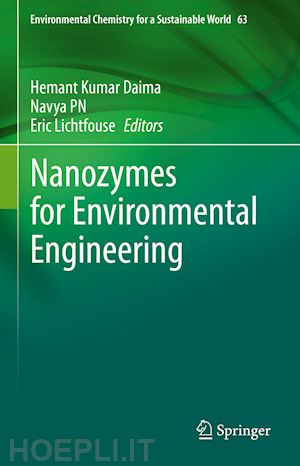
Questo prodotto usufruisce delle SPEDIZIONI GRATIS
selezionando l'opzione Corriere Veloce in fase di ordine.
Pagabile anche con Carta della cultura giovani e del merito, 18App Bonus Cultura e Carta del Docente
This book reviews the latest developments and applications of nanozymes in environmental science. Protection of the environment is essential because pollution has become a global problem with many adverse effects on life and ecosystems. For that, remediation strategies and techniques have been designed, yet they are limited. Here, the recent development of nanotechnology opens a new vista for environmental remediation. In particular, nanomaterials displaying enzyme-like activities, named ‘nanozymes’, appear very promising for environmental monitoring, contaminant detection, microbial management, and degradation of organic pollutants. Nanomaterials including metallic, metal oxides and carbon-based nanoparticles with nanozymes activities have been synthesized. These nanozymes have similar activities as natural peroxidase, oxidase, superoxide dismutase and catalase enzymes. Nanozymes have several advantages, yet they suffer from several limitations such as low catalytic efficiency, less substrate selectivity, biocompatibility, and lack of engineering of the active sites.
Dr. Hemant Kumar Daima, is nano-biotechnology expert at Amity University Rajasthan, India and visiting scientist at RMIT University, Australia. His research findings have revealed guiding principles involved in rational nanoparticle design strategies for biomedical applications. He is editorial member of leading scientific publishers, member of numerous scientific/professional bodies, and recipient of international fellowships/awards.
Navya PN is assistant professor at the Bannari Amman Institute of Technology, India. She is cofounder of Nano-Bio Interfacial Research Laboratory (NBIRL). Her research works are at the interface between nanotechnology and biology. She is recipient of several international fellowships.
Dr. Eric Lichtfouse is professor of environmental chemistry and scientific communication at Aix-Marseille University, France and Xi’an Jiaoting University, China. He has invented carbon-13 dating based on the discovery of temporal pools of organic molecules in soils. He is Chief Editor and co-founder of the journal Environmental Chemistry Letters, and the book series Sustainable Agriculture Reviews and Environmental Chemistry for a Sustainable World. He has published the book Scientific Writing for Impact Factor Journals.











Il sito utilizza cookie ed altri strumenti di tracciamento che raccolgono informazioni dal dispositivo dell’utente. Oltre ai cookie tecnici ed analitici aggregati, strettamente necessari per il funzionamento di questo sito web, previo consenso dell’utente possono essere installati cookie di profilazione e marketing e cookie dei social media. Cliccando su “Accetto tutti i cookie” saranno attivate tutte le categorie di cookie. Per accettare solo deterninate categorie di cookie, cliccare invece su “Impostazioni cookie”. Chiudendo il banner o continuando a navigare saranno installati solo cookie tecnici. Per maggiori dettagli, consultare la Cookie Policy.